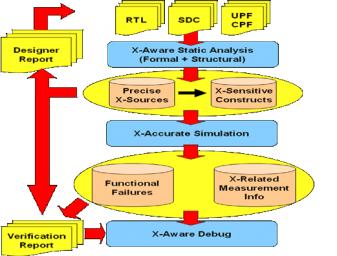The SystemVerilog standard defines an X as an “unknown” value which is used to represent when simulation cannot definitely resolve a signal to a “1”, a “0”, or a “Z”. Synthesis, on the other hand, defines an X as a “don’t care”, enabling greater flexibility and optimization. Unfortunately, Verilog RTL simulation semantics often mask propagation of an unknown value by converting the unknown to a known, while gate-level simulations show additional Xs that will not exist in real hardware. The result is that bugs get masked in RTL simulation, and while they show up at the gate level, time consuming iterations between simulation and synthesis are required to debug and resolve them. Resolving differences between gate and RTL simulation results is painful because synthesized logic is less familiar to the user, and Xs make correlation between the two harder. Unwarranted X-propagation thus proves costly, causes painful debug, and sometimes allows functional bugs to slip through to silicon.
Continued increases in SOC integration and the interaction of blocks in various states of power management are exacerbating the X problem. In simulation, the X value is assigned to all memory elements by default. While hardware resets can be used to initialize registers to known values, resetting every flop or latch is not practical because of routing overhead. For synchronous resets, synthesis tools typically club these with data-path signals, thereby losing the distinction between X-free logic and X-prone logic. This in turn causes unwarranted X-propagation during the reset simulation phase. State-of-the-art low power designs have additional sources of Xs with the additional complexity that they manifest dynamically rather than only during chip power up.
Lisa Piper, from Real Intent, presented on this topic at DVCon 2012 and she described a flow in her paper that mitigates X-issues. The flow is reproduced here.
She describes a solution to the X-propagation problem that is part technology and part methodology. The flow brings together structural analysis, formal analysis, and simulation in a way that addresses all the problems and can be scaled. In the figure above, it shows the use model for the design engineer and the verification engineer. The solution is static analysis centered for the design engineer and is primarily simulation-based for the verification engineer. Also, the designer centric flow is preventative in nature while the verification flow is intended to identify and debug issues.
She also gave a video interview on her presentation at DVCon 2012 and you can watch it here.
Share this post via:






Real men have fabs!